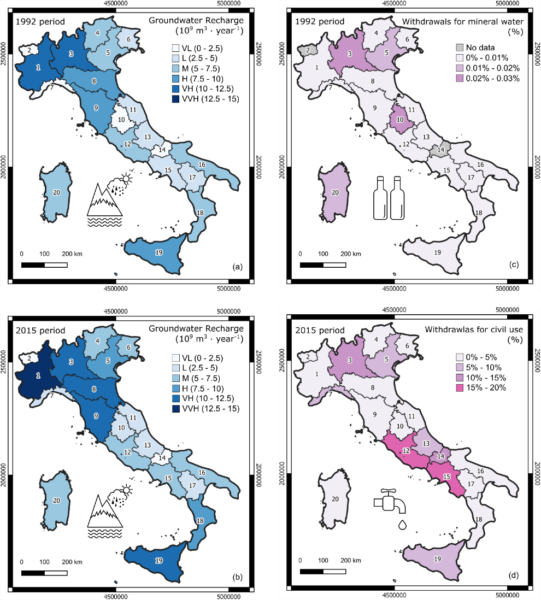Nationwide groundwater recharge evaluation for a sustainable water withdrawal over Italy. A new study published on “Journal of Hydrology: Regional Studies”

The article, titled “Nationwide groundwater recharge evaluation for a sustainable water withdrawal over Italy” has been recently published in the Journal of Hydrology: Regional Studies. The study was co-authored by Mauro Rossi & Marco Donnini from Cnr Irpi and Giulio Beddini from the University of Perugia.
In synthesis
The study evaluates over Italy the groundwater recharge, that is the amount of water that infiltrates into the soil recharging aquifers. The estimated groundwater recharge is compared with the water withdrawals for the mineral water industry and for civil use in specified years. The results show that the groundwater recharge varies regionally, mostly influenced by the precipitation distribution, elevation, and soil characteristics. Overall, the water withdrawals in Italy are sustainable in the analysed years, but not-negligible being approximately 10-15% of groundwater recharge.
In detail
The analyses were performed using the open source water balance model tool (HYDRO-BM) developed by Rossi & Donnini (2018) over a grid of 10 km × 10 km and the following gratis/libre open access data: (i) soil elevation data from the digital elevation model TINITALY/01 (https://tinitaly.pi.ingv.it/); (ii) precipitation (cumulative daily) and temperature (minimum and maximum daily) from 1981 to 2010 from the SCIA database of ISPRA (http://www.scia.isprambiente.it); (iii) soil and lithology data from the European Soil Database (https://esdac.jrc.ec.europa.eu/). The model was calibrated and validated with reference to literature data available for the area of Apennines (Central Italy). Groundwater recharge values were compared with the most recent water withdrawals data available in the scientific literature: (i) water withdrawn during 1992 for mineral water industry; and (ii) water withdrawn during 2015 for civil use.
The results shows that groundwater recharge estimated in the 1981-2010 period is on average 110 billion of cubic meters per year showing significant yearly variation. In 1992 and 2015 the groundwater recharge exceeded the average value by 3% and 27%, respectively. In 1992, the withdrawal for the mineral water industry was approximately 0.01% of the groundwater recharge and that for civil use was approximately 10% in 2015. Overall, the results show (i) that the 1981–2010 average groundwater withdrawals for civil, industrial, and agricultural use were sustainable, but not-negligible, being approximately 14% of the averaged groundwater recharge for the same period; (ii) the sustainability of water withdrawals varied regionally.
The proposed methodology allows for the evaluation of the sustainability of water withdrawals at the regional and national scale, in line with the Goal 6 of the 2030 Agenda for Sustainable Development of United Nations (“Ensure availability and sustainable management of water and sanitation for all”, see https://sdgs.un.org). Moreover, the proposed approach may have strategic importance for developing countries, which are affected by water limited availability and have sustainability issues, especially in the context of climate change.
Citation: Rossi M., Donnini M., Beddini G. (2022). Nationwide groundwater recharge evaluation for a sustainable water withdrawal over Italy. Journal of Hydrology: Regional Studies, Volume 43, 101172, ISSN 2214-5818, https://doi.org/10.1016/j.ejrh.2022.101172.
Web link: https://doi.org/10.1016/j.ejrh.2022.101172
Additional references: Rossi, M., & Donnini, M. (2018). Estimation of regional scale effective infiltration using an open source hydrogeological balance model and free/open data. Environmental Modelling & Software, 104, 153-170. https://doi.org/10.1016/j.envsoft.2018.03.005

Groundwater recharge estimated in 1992 (a) and 2015 (b) and percentage of water withdrawn for mineral water industry in 1992 (c) and for civil use in 2015 (d).





